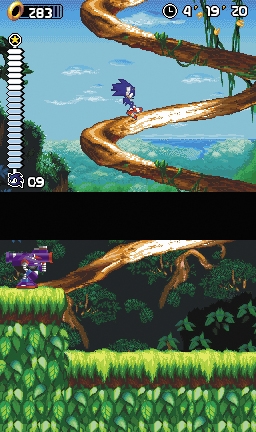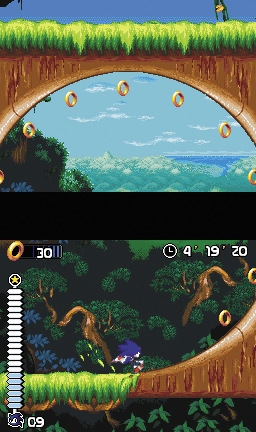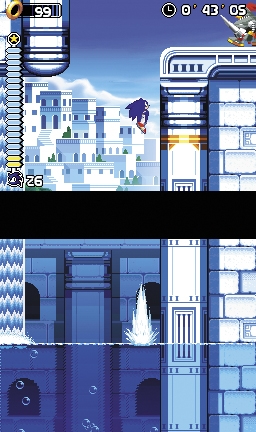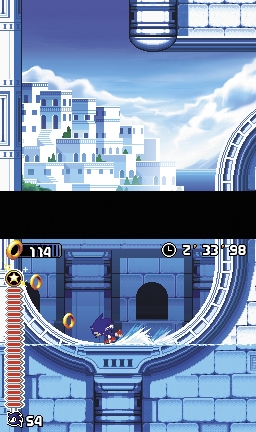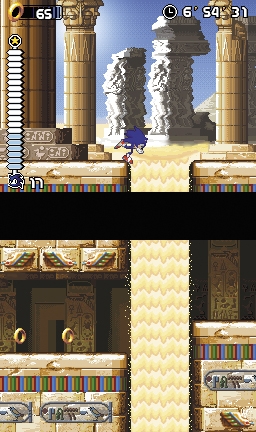Sonic Rush Review
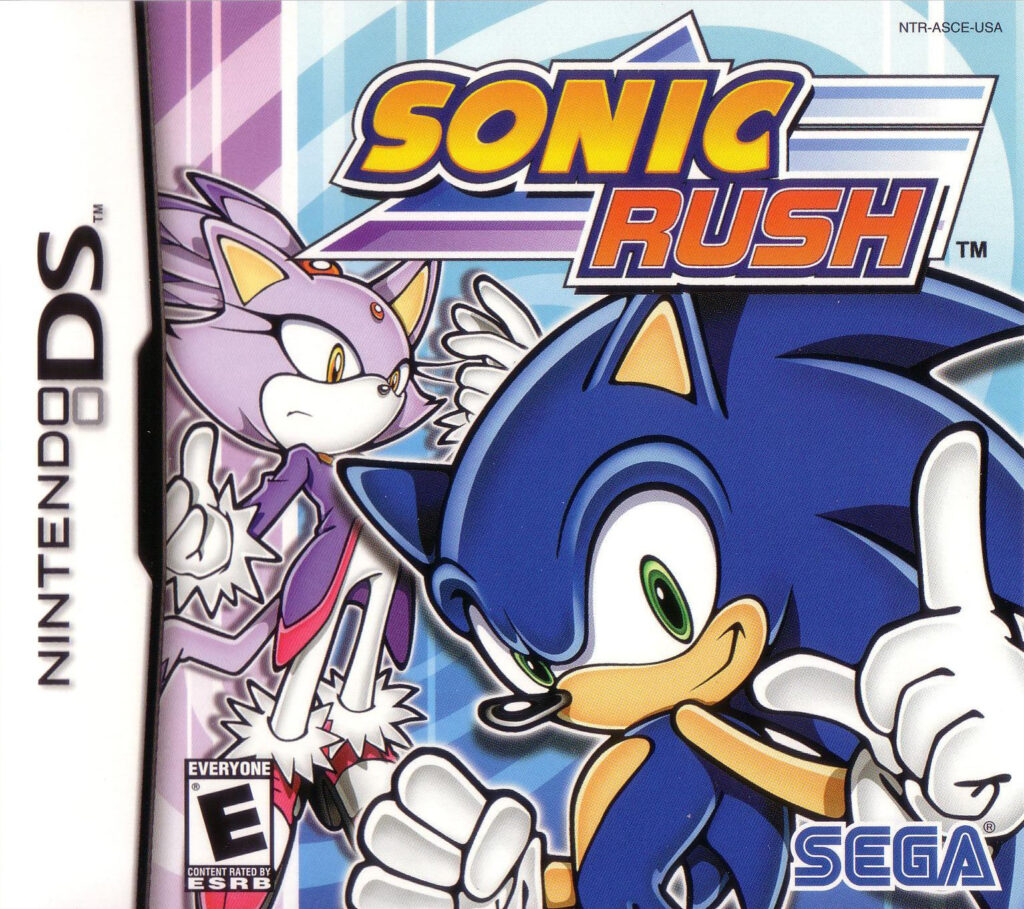
A new Sonic game with great production values but questionable level design.
Story
The notorious Eggman is back with his standard share of mischief. Sonic the Hedgehog is on the scene at no time, toe to toe with the menacing presence of the mad man. Eggman is, before he knows it whacked into submission and forced to retreat – but on his way to safety he drops a strange-looking emerald – not quite like the legendary Chaos Emeralds. Sonic approaches to pick the thing up but before he does, it’s snatched from under his nose! It appears that a mysterious cat-like character is after these emeralds. Now Sonic has a new problem on his hands – what’s going on!?
The Game
Sonic Rush is the first Sonic game to appear on the Nintendo DS hand-held console. It builds heavily on the basic and well-known Sonic formula; a lightning fast platform game where you run around on a level, starting at point A and trying to reach point B. As such, the game is a pretty standard side-scrolling platform game with a few quirks mixed into it. Sonic and the other characters are rendered in 3D this time around, but the game still plays like a normal 2D side-scroller, with the exception of the boss fights which are all in full 3D.
Content
As well as having the novel experience of playing Sonic on a portable device, you’ll also be introduced to the new mysterious character to the Sonic universe named Blaze the Cat. Before you start playing the single-player story mode, you’ll be prompted to choose whether you want to play as Sonic or Blaze. They both start at different locations in the world as they both are looking for Eggman’s whereabouts and the emeralds known as Sol Emeralds. In practice this means that there are two parallel stories going on at the same time, and they intertwine with one another.
In total there are eight zones to play in, and each zone except the last one consists of two acts and a boss act. The acts in turn are huge and have many secret and alternative paths – it’s quite breathtaking to be speeding around in a level that’s so open in every direction. During the course of the game you’ll be visiting many entirely new locations such as the Night Carnival (that reminds us about the Casino Night Zone in Sonic the Hedgehog 2), and the lush Leaf Storm Zone.
Sonic and Blaze will visit the same areas, but in a different order. Depending on who you play as, you’ll be able to reach different areas and paths in each of the zones thanks to their different moves – Sonic is fast, but Blaze can spin up into a flaming tornado and briefly float in the air thanks to this. You might think that this is a cheap way to add length and replay value to a mere eight zones, and I partly agree. But at the same it works well with the story and seeing the levels are so large, they really offer many paths and you’ll keep discovering new secrets and alternative routes even on your tenth time through.
Not only are the levels filled with trampolines and devices that allow you to perform all-new kind of stunts and jumps, but you’ve also been granted a so-called ‘tension gauge’. This is a special feature to measure your character’s tension. This is shown as a gauge that builds up when you hit enemies, for example. The bars fill up very easily, so most of the time you don’t really have to worry about it. This tension can be used to perform a special move called Super Boost (or Fire Boost for Blaze) that gives you an insane burst of speed. So to maximize your time records, you’d need to balance your game between finding the fastest possible path through each of the levels, fighting enemies, and bursting away with Super Boost. This is a prime example of a new feature that really works well and could easily be implemented into future Sonic titles to add a new layer of depth and excitement.
There are other minor new features included too, such as the ability to do tricks. You can perform tricks in the air or while grinding on rails, and the more tricks you pull off the better your score will be. Tricks can also be used to build up your tension gauge. Sonic Rush also lets you swing in ropes and bash through walls.
There’s also the hidden special stages where Sonic is rushing down a pipe and he is seen from behind, just like in Sonic the Hedgehog 2. These stages are played by controlling Sonic with the stylus – and these are the stages where you can collect the seven Chaos Emeralds, and potentially unlocking the ultimate power of Sonic.
One thing that certainly sets Sonic Rush apart from previous Sonic titles is the level of difficulty. In Sonic Rush, more than ever will you have to worry about how many lives you’ve got left, because there are deadly pitfalls all over the place. There’s no way to see where these pitfalls are ahead of time, so by the time you fall into one it’s already too late. Once you’ve found one such chasm, you have to memorize where it is, and how to avoid it, of course. But this is no easy task because of the sheer size of the levels. Thus we feel that the level design in Sonic Rush is hit-and-miss. Having large chasms everywhere isn’t that fun when you can’t even see where you are going or where the platforms are. It’s nice to have a tricky challenge ahead, but some of these chasms are just annoying. You can be sure that this game will test your patience on this.
On a brighter note, they’ve really put effort in the boss fights – they’re all unique, look horrifying and require special tactics. As mentioned the boss fights utilize the third dimension. They typically take place on an arena, and the camera can rotate and revolve around you, often to allow you to react to some new danger Eggman throws at you. It all makes for even more engaging and varied boss fights, and it’s a nice surprise to pull on an unsuspecting player to evoke that wow-effect.
After each stage you’ll be ranked on how well you performed in terms of time, rings and amount of tricks performed. Thanks to this you can keep trying to beat your score on each of the stages – you can revisit a zone as many times you want after you have beaten it once.
Multiplayer
On top of the core single-player mode sits a multiplayer mode known as Battle Play. You can play four out of the 14 acts against a friend using single card play, but you need to play multi-card to be able to compete on the rest of the stages. The Battle Play is all about Sonic and Blaze competing to reach the end of the level. When racing against another player you’ll be able to bump into each other, and with a press of a button you can push yourself forward with the help of the rival. A fun little distraction, but hardly anything that will engage you in the long run.
Graphics
The graphics in Sonic Rush are pretty good. There’s lots of colorful environments to explore and the enemies all look great. It’s not a huge step forward from previous Sonic titles, even though there’s use of 3D characters. The 3D characters themselves are well done, and assumes a cell-shading look, which suits the theme and style well enough. The only problem with 3D characters used this way is that they can look a little grainy when viewed at a distance, due to the resolution of the DS screen.
The dual screens of the DS is used in a clever way here. You’ll be running around on both screens, as the camera seamlessly follows your moves though the level. It looks very natural and adds to the impression that there’s much going on and that the stages are huge.
The game also has some notable slow downs in terms of frame rate, which of course deducts from the illusion of high-speed running, but it doesn’t interfere much at all with the actual gameplay experience.
Sound
Musically Sonic Rush really takes a bold step. The soundtrack throughout the game is incredibly funky and has an attitude. It’s hard to describe. It’s very upbeat, fast and catchy, drawing influences from many musical genres, but mostly from drum ‘n bass, funk, hip-hop, house and the likes. If you’re familiar with the music in Jet Set Radio, you’ll instantly recognize the unique style as this is the work of the same composer. The music and sound are top-notch and gives the game much of its fresh and cool style. Each zone has its distinct songs, but they’re all of the same high standard.
Summary
Sonic Rush is an intense experience. There’s a lot to discover in the game but because of its many unforgiving traps it can be incredibly annoying at times – it certainly doesn’t have the same kind of flow we’ve seen in previous games in the series. However, it’s still a worthy addition to the Sonic game series, and parts of it is a total blast to play. If only the level design was solid, this would have been really great.
